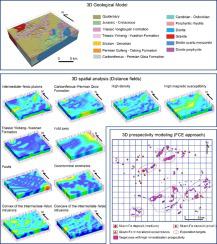Ore Geology Reviews ( IF 3.2 ) Pub Date : 2022-08-17 , DOI: 10.1016/j.oregeorev.2022.105065 He Li , Xiaohui Li , Feng Yuan , Simon M. Jowitt , Fanfan Dou , Mingming Zhang , Xiangling Li , Yue Li , Xueyi Lan , Sanming Lu , Wenxiang Ding

|
Mineral exploration at depth is becoming increasingly important as a result of the decades of discovery and mining of surficial or near-surface mineralization, leading to targeting of deeper-seated mineralization and mineral systems. The numerous challenges posed by this transition to deeper exploration can be partly overcome by the application of 3D prospectivity modeling. This study provides an outline of this type of prospectivity modeling and focuses on the under-explored Fanchang volcanic basin, an area prospective for skarn-type Fe–Cu mineralization within the Middle–Lower Yangtze River Metallogenic belt (MLYRB) of eastern China. The approach used utilizes a 3D geological model of the Fanchang volcanic basin that enables the identification and extraction of favorable elements for mineralization using 3D spatial and mathematical morphology analysis methods. A 3D distance field method was also used to obtain distance field information for the favorable ore-forming factors delineated during this study. The limited exploration to date in the study area means that there is a lack of specific information (e.g., location, size, grade) for the mineralization in this region. As such, knowledge-driven Index Overlay with Multi-Class (IOMC), Technique for Order Preference by Similarity to an Ideal Solution (TOPSIS), and Fuzzy Comprehensive Evaluation (FCE) approaches were used to generate 3D prospectivity models for the Fanchang volcanic basin. The resulting weight coefficients relating to favorable ore-forming factors were quantified using an Analytic Hierarchy Process (AHP) approach, yielding random consistency ratio (CR) values of 0.0125. These are all less than a value of 0.1, which would indicate inconsistencies between the matrix values and values for the entirety of the hierarchy, indicating that our calculated weighting coefficients are precise and accurate. Comparison of the 3D prospectivity modeling results of the three methods using a prediction area (P–A) plot indicates that 88% of the known mineralization and mineralized occurrences within the basin were located within an area of only 12% of the study area considered prospective during modeling using the IOMC method. In comparison, TOPSIS and FCE modeling positively identified 82% (18% of the study area) and 91% (9% of the study area) of the mineralization in the study area, respectively. These results indicate that these approaches are viable tools for exploration targeting in relatively unexplored areas without specific orebody size, location, and grade data, and the FCE method appears more efficient and reliable than the other two methods in predicting locations to explore for Fe–Cu skarn mineralization. The approaches outlined during this study are widely applicable for exploration for other mineralizing systems in under-explored regions elsewhere and the specific high prospectivity targets identified during this study and the links between exploration indicators and high prospectivity regions also provide key areas and insights for both future modeling and mineral exploration within the Fanchang volcanic basin and the wider MLYRB.











































 京公网安备 11010802027423号
京公网安备 11010802027423号